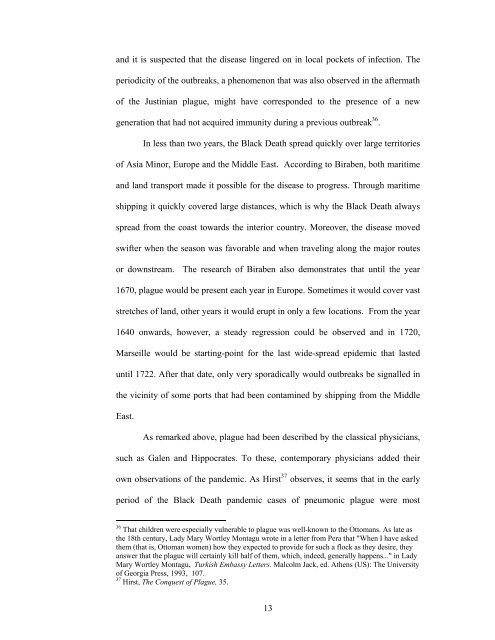the black death in early ottoman territories - Bilkent University
the black death in early ottoman territories - Bilkent University
the black death in early ottoman territories - Bilkent University
You also want an ePaper? Increase the reach of your titles
YUMPU automatically turns print PDFs into web optimized ePapers that Google loves.
and it is suspected that <strong>the</strong> disease l<strong>in</strong>gered on <strong>in</strong> local pockets of <strong>in</strong>fection. The<br />
periodicity of <strong>the</strong> outbreaks, a phenomenon that was also observed <strong>in</strong> <strong>the</strong> aftermath<br />
of <strong>the</strong> Just<strong>in</strong>ian plague, might have corresponded to <strong>the</strong> presence of a new<br />
generation that had not acquired immunity dur<strong>in</strong>g a previous outbreak 36 .<br />
In less than two years, <strong>the</strong> Black Death spread quickly over large <strong>territories</strong><br />
of Asia M<strong>in</strong>or, Europe and <strong>the</strong> Middle East. Accord<strong>in</strong>g to Biraben, both maritime<br />
and land transport made it possible for <strong>the</strong> disease to progress. Through maritime<br />
shipp<strong>in</strong>g it quickly covered large distances, which is why <strong>the</strong> Black Death always<br />
spread from <strong>the</strong> coast towards <strong>the</strong> <strong>in</strong>terior country. Moreover, <strong>the</strong> disease moved<br />
swifter when <strong>the</strong> season was favorable and when travel<strong>in</strong>g along <strong>the</strong> major routes<br />
or downstream. The research of Biraben also demonstrates that until <strong>the</strong> year<br />
1670, plague would be present each year <strong>in</strong> Europe. Sometimes it would cover vast<br />
stretches of land, o<strong>the</strong>r years it would erupt <strong>in</strong> only a few locations. From <strong>the</strong> year<br />
1640 onwards, however, a steady regression could be observed and <strong>in</strong> 1720,<br />
Marseille would be start<strong>in</strong>g-po<strong>in</strong>t for <strong>the</strong> last wide-spread epidemic that lasted<br />
until 1722. After that date, only very sporadically would outbreaks be signalled <strong>in</strong><br />
<strong>the</strong> vic<strong>in</strong>ity of some ports that had been contam<strong>in</strong>ed by shipp<strong>in</strong>g from <strong>the</strong> Middle<br />
East.<br />
As remarked above, plague had been described by <strong>the</strong> classical physicians,<br />
such as Galen and Hippocrates. To <strong>the</strong>se, contemporary physicians added <strong>the</strong>ir<br />
own observations of <strong>the</strong> pandemic. As Hirst 37 observes, it seems that <strong>in</strong> <strong>the</strong> <strong>early</strong><br />
period of <strong>the</strong> Black Death pandemic cases of pneumonic plague were most<br />
36 That children were especially vulnerable to plague was well-known to <strong>the</strong> Ottomans. As late as<br />
<strong>the</strong> 18th century, Lady Mary Wortley Montagu wrote <strong>in</strong> a letter from Pera that "When I have asked<br />
<strong>the</strong>m (that is, Ottoman women) how <strong>the</strong>y expected to provide for such a flock as <strong>the</strong>y desire, <strong>the</strong>y<br />
answer that <strong>the</strong> plague will certa<strong>in</strong>ly kill half of <strong>the</strong>m, which, <strong>in</strong>deed, generally happens..." <strong>in</strong> Lady<br />
Mary Wortley Montagu, Turkish Embassy Letters. Malcolm Jack, ed. A<strong>the</strong>ns (US): The <strong>University</strong><br />
of Georgia Press, 1993, 107.<br />
37 Hirst, The Conquest of Plague, 35.<br />
13
















